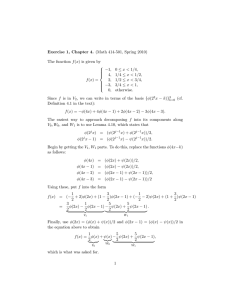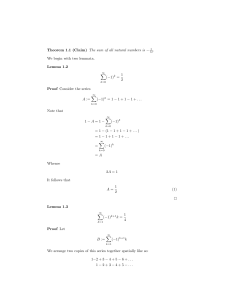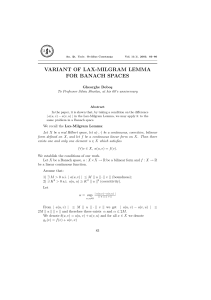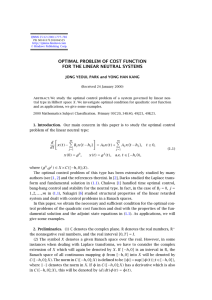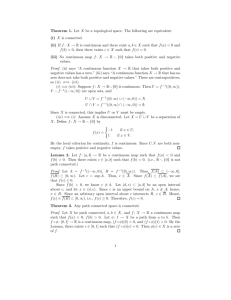Document 10832220
advertisement
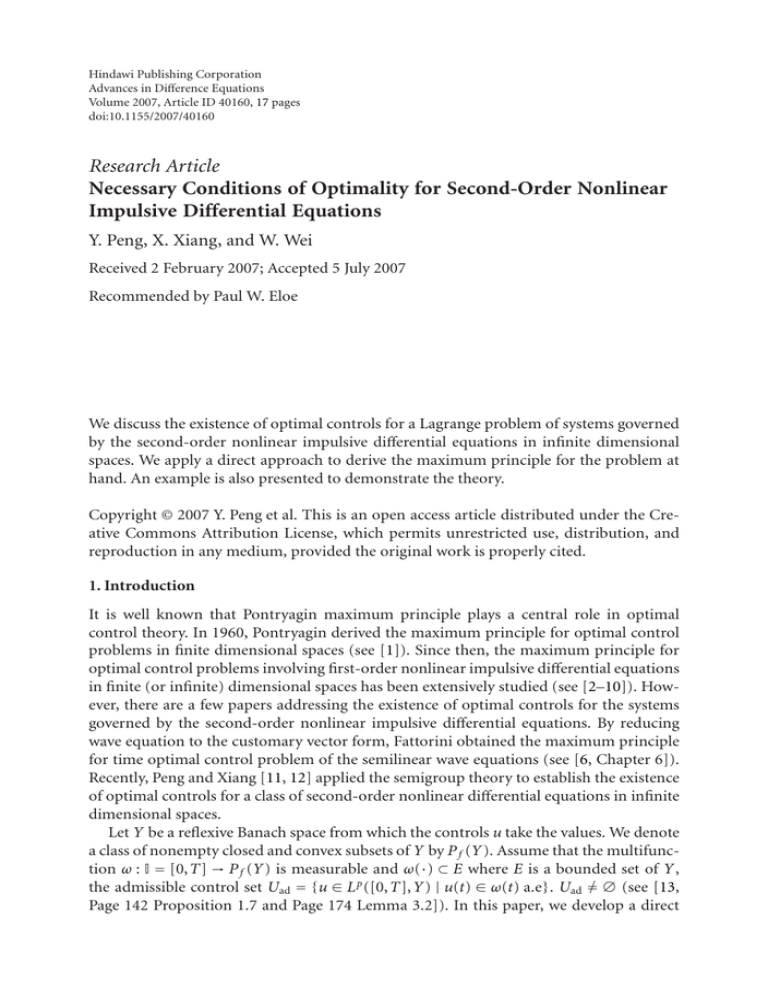
Hindawi Publishing Corporation
Advances in Difference Equations
Volume 2007, Article ID 40160, 17 pages
doi:10.1155/2007/40160
Research Article
Necessary Conditions of Optimality for Second-Order Nonlinear
Impulsive Differential Equations
Y. Peng, X. Xiang, and W. Wei
Received 2 February 2007; Accepted 5 July 2007
Recommended by Paul W. Eloe
We discuss the existence of optimal controls for a Lagrange problem of systems governed
by the second-order nonlinear impulsive differential equations in infinite dimensional
spaces. We apply a direct approach to derive the maximum principle for the problem at
hand. An example is also presented to demonstrate the theory.
Copyright © 2007 Y. Peng et al. This is an open access article distributed under the Creative Commons Attribution License, which permits unrestricted use, distribution, and
reproduction in any medium, provided the original work is properly cited.
1. Introduction
It is well known that Pontryagin maximum principle plays a central role in optimal
control theory. In 1960, Pontryagin derived the maximum principle for optimal control
problems in finite dimensional spaces (see [1]). Since then, the maximum principle for
optimal control problems involving first-order nonlinear impulsive differential equations
in finite (or infinite) dimensional spaces has been extensively studied (see [2–10]). However, there are a few papers addressing the existence of optimal controls for the systems
governed by the second-order nonlinear impulsive differential equations. By reducing
wave equation to the customary vector form, Fattorini obtained the maximum principle
for time optimal control problem of the semilinear wave equations (see [6, Chapter 6]).
Recently, Peng and Xiang [11, 12] applied the semigroup theory to establish the existence
of optimal controls for a class of second-order nonlinear differential equations in infinite
dimensional spaces.
Let Y be a reflexive Banach space from which the controls u take the values. We denote
a class of nonempty closed and convex subsets of Y by P f (Y ). Assume that the multifunction ω : I = [0,T] → P f (Y ) is measurable and ω(·) ⊂ E where E is a bounded set of Y ,
the admissible control set Uad = {u ∈ L p ([0,T],Y ) | u(t) ∈ ω(t) a.e}. Uad = ∅ (see [13,
Page 142 Proposition 1.7 and Page 174 Lemma 3.2]). In this paper, we develop a direct
2
Advances in Difference Equations
technique to derive the maximum principle for a Lagrange problem of systems governed
by a class of the second-order nonlinear impulsive differential equation in infinite dimensional spaces. Consider the following second-order nonlinear impulsive differential
equations:
ẍ(t) = Aẋ(t) + f t,x(t), ẋ(t) + B(t)u(t),
x(0) = x0 ,Δl x ti = Ji0 x ti ,
ẋ(0) = x1 ,Δl ẋ ti = Ji1 ẋ ti ,
t ∈ (0,T] \ Θ,
ti ∈ Θ, i = 1,2,...,n,
(1.1)
ti ∈ Θ, i = 1,2,...,n,
where the A is the infinitesimal generator of a C0 -semigroup in a Banach space X, Θ =
{ti ∈ I | 0 = t0 < t1 < · · · < tn < tn+1 = T }, Ji0 , Ji1 (i = 1,2,...,n) are nonlinear maps, and
Δl x(ti ) = x(ti + 0) − x(ti ), Δl ẋ(ti ) = ẋ(ti + 0) − ẋ(ti ). We denote the jump in the state x, ẋ
at time ti , respectively, with Ji0 , Ji1 determining the size of the jump at time ti .
As a first step, we use the semigroup {S(t), t ≥ 0} generated by A to construct the
semigroup generated by the operator matrix A (see Lemma 2.2). Then, the existence and
uniqueness of PCl -mild solution for (1.1) are proved. Next, we consider a Lagrange problem of system governed by (1.1) and prove the existence of optimal controls. In order to
derive the optimality conditions for the system (1.1), we consider the associated adjoint
equation and convert it to a first-order backward impulsive integro-differential equation with unbounded impulsive conditions. We note that the resulting integro-differential
equation cannot be turned into the original problem by simple transformation s = T − t
(see (4.9)). Subsequently, we introduce a suitable mild solution for adjoint equation and
give a generalized backward Gronwall inequality to find a priori estimate on the solution
of adjoint equation. Finally, we make use of Yosida approximation to derive the optimality conditions.
The paper is organized as follows. In Section 2, we give associated notations and preliminaries. In Section 3, the mild solution of second-order nonlinear impulsive differential equations is introduced and the existence result is also presented. In addition, the
existence of optimal controls for a Lagrange problem (P) is given. In Section 4, we discuss corresponding the adjoint equation and directly derive the necessary conditions by
the calculus of variations and the Yosida approximation. At last, an example is given for
demonstration.
2. Preliminaries
In this section, we give some basic notations and preliminaries. We present some basic notations and terminologies. Let £(X) be the class of (not necessary bounded) linear
operators in Banach space X. £b (X) stands for the family of bounded linear operators
in X. For A ∈ £(X), let ρ(A) denote the resolvent set and R(λ,A) the resolvent corresponding to λ ∈ ρ(A). Define PCl (I,X) (PCr (I,X)) = {x : I → X | x is continuous at t ∈
I \ Θ,x is continuous from left (right) and has right- (left-) hand limits at ti ∈ Θ}. PCl1 (I,
X) = {x ∈ PCl (I,X) | ẋ ∈ PCl (I,X)}, PCr1 (I,X) = {x ∈ PCr (I,X) | ẋ ∈ PCr (I,X)}. Set
xPC = max sup x(t + 0),sup x(t − 0) ,
t ∈I
t ∈I
xPC1 = xPC + ẋPC .
(2.1)
Y. Peng et al. 3
It can be seen that endowed with the norm · PC ( · PC1 )PCl (I,X)(PCl1 (I,X)) and
PCr (I,X)(PCr1 (I,X)) are Banach spaces.
In order to construct the C0 -semigroup generated by A, we need the following lemma
([14, Theorem 5.2.2]).
Lemma 2.1. Let A be a densely defined linear operator in X with ρ(A) = ∅. Then the Cauchy
problem
ẋ(t) = Ax(t),
t > 0,
(2.2)
x(0) = x0
has a unique classical solution for each x0 ∈ D(A) if, and only if, A is the infinitesimal generator of a C0 -semigroup {S(t),t ≥ 0} in X.
In the following lemma we construct the C0 -semigroup generated by A.
Lemma 2.2 [12, Lemma 1]. Suppose A is the infinitesimal generator of a C0 -semigroup
{S(t),t ≥ 0} on X. Then A = ( 00 AI ) is the infinitesimal generator of a C0 -semigroup {S(t),t ≥
0} on X × X, given by
I
S(t) =
0
t
0 S(τ)dτ
S(t)
.
(2.3)
Proof. Obviously, A is a densely defined linear operator in X × X with ρ(A) = ∅ according to assumption.
Consider the following initial value problem:
ẍ(t) = Aẋ(t),
t ∈ (0,T],
x(0) = x0 ,
ẋ(0) = x1 ∈ D(A).
(2.4)
It is to see that the classical solution of (2.4) can be given by
x(t) = x0 +
t
0
ẋ(t) = S(t)x1 .
S(τ)x1 dτ,
(2.5)
x0
Setting v0 (t) = x(t), v1 (t) = ẋ(t), v(t) = ( vv01 (t)
(t) ), v0 = ( x1 ) ∈ D(A) = X × D(A), (2.4)
can be rewritten as
v̇(t) = Av(t),
t ∈ (0,T],
v(0) = v0 ∈ D(A),
(2.6)
and (2.6) has a unique classical solution v given by
I
v(t) =
0
t
0 S(τ)dτ
S(t)
v0 .
Using Lemma 2.1, A generates a C0 -semigroup {S(t),t ≥ 0}.
(2.7)
In order to study the existence of optimal control and necessary conditions of optimality, we also need some important lemmas. For reader’s convenience, we state the following
results.
4
Advances in Difference Equations
Lemma 2.3 [7, Lemma 3.2]. Suppose A is the infinitesimal generator of a compact semigroup
{S(t),t ≥ 0} in X. Then the operator Q : L p ([0,T],X) → C([0,T],X) with p > 1 given by
(Q f )(t) =
t
0
S(t − τ) f (τ)dτ
(2.8)
is strongly continuous.
Lemma 2.4 [15, Lemma 1.1]. Let ϕ ∈ C([0,T],X) satisfy the following inequality:
ϕ(t) ≤ a + b
t
0
ϕ(s)ds + c
t
0
ϕs ds
B
∀t ∈ [0,t],
(2.9)
where a,b,c ≥ 0 are constants, and ϕs B = sup0≤τ ≤s ϕ(τ). Then
ϕ(t) ≤ ae(b+c)t .
(2.10)
3. Existence of optimal controls
In this section, we not only present the existence of PCl -mild solution of the controlled
system (1.1) but also give the existence of optimal controls of systems governed by (1.1).
We consider the following controlled system:
ẍ(t) = Aẋ(t) + f t,x(t), ẋ(t) + B(t)u(t),
0 Δl x ti = Ji x ti ,
x(0) = x0 ,
t ∈ (0,T] \ Θ,
1
Δl ẋ ti = Ji ẋ ti ,
ẋ(0) = x1 ,
ti ∈ Θ,
(3.1)
u ∈ Uad ,
and naturally introduce its mild solution.
Definition 3.1. A function x ∈ PCl1 (I,X) is said to be a PCl -mild solution of the system
(3.1) if x satisfies the following integral equation:
x(t) = x0 +
+
t
0
t
t
S(s)x1 ds +
0
Ji x ti
0<ti <t
τ
0
t
+
ti
S(s − τ) f τ,x(τ), ẋ(τ) + B(τ)u(τ) dsdτ
(3.2)
S s − ti Ji1 ẋ ti ds .
For the forthcoming analysis, we need the following assumptions:
[B]: B ∈ L∞ (I,£(Y ,X));
[F]: (1) f : I × X × X → X is measurable in t ∈ I and locally Lipschitz continuous with
respect to last two variables, that is, for all x1 ,x2 , y1 , y2 ∈ X, satisfying x1 , x2 , y1 ,
y2 ≤ ρ, we have
f t,x1 , y1 − f t,x2 , y2 ≤ L(ρ) x1 − x2 + y1 − y2 ;
(3.3)
(2) there exists a constant a > 0 such that
f (t,x, y) ≤ a 1 + x + y ∀x, y ∈ X;
(3.4)
Y. Peng et al. 5
[J]: (1) Ji0 (Ji1 ) : X → X (i = 1,2,...,n) map bounded set of X to bounded set of X;
(2) There exist constants ei0 ,ei1 ≥ 0 such that maps Ji0 ,Ji1 : X → X satisfy
0
J (x) − J 0 (y) ≤ e0 x − y ,
i
i
i
1
J (x) − J 1 (y) ≤ e1 x − y i
i
∀x, y ∈ X (i = 1,2,...,n).
i
(3.5)
Similar to the proof of existence of mild solution for the first-order impulsive evolution
equation (see [16]), one can verify the basic existence result. Here, we have to deal with
space PCl1 (I,X) instead.
Theorem 3.2. Suppose that A is the infinitesimal generator of a C0 -semigroup. Under assumptions [B], [F], and [J](1), the system (3.1) has a unique PCl -mild solution for every
u ∈ Uad .
Proof. Consider the map H given by
(Hx)(t) = x0 +
t
0
t
t
S(s)x1 ds +
τ
0
S(s − τ) f τ,x(τ), ẋ(τ) + B(τ)u(τ) dsdτ
(3.6)
on
B x0 ,x1 ,1 = x ∈ C 1 0,T1 ,X | ẋ(t) − x1 + x(t) − x0 ≤ 1, 0 ≤ t ≤ T1 ,
(3.7)
where T1 would be chosen. Using assumptions and properties of semigroup, we can show
that H is a contraction map and obtain local existence of mild solution for the following
differential equation without impulse:
ẍ(t) = Aẋ(t) + f t,x(t), ẋ(t) + B(t)u(t),
x(0) = x0 ,
ẋ(0) = x1 ,
t ∈ (0,T],
(3.8)
u ∈ Uad .
The global existence comes from a priori estimate of mild solution in space C 1 (I,X) which
can be proved by Gronwall lemma.
Step by step, the existence of PCl -mild solution of (3.1) can be derived.
Let xu denote the PCl -mild solution of system (3.1) corresponding to the control u ∈
Uad , then we consider the Lagrange problem (P):
find u0 ∈ Uad such that
J u0 ≤ J(u),
∀u ∈ Uad ,
(3.9)
where
J(u) =
T
0
l t,xu (t), ẋu (t),u(t) dt.
(3.10)
Suppose that
[L]: (1) the functional l : I × X × X × Y → R ∪ {∞} is Borel measurable;
(2) l(t, ·, ·, ·) is sequentially lower semicontinuous on X × Y for almost all t ∈ I;
(3) l(t,x, y, ·) is convex on Y for each (x, y) ∈ X × X and almost all t ∈ I;
6
Advances in Difference Equations
(4) there exist constants b ≥ 0, c > 0 and ϕ ∈ L1 (I,R) such that
p
l(t,x, y,u) ≥ ϕ(t) + b x + y + cuY
∀x, y ∈ X, u ∈ Y.
(3.11)
Now we can give the following result on existence of the optimal controls for problem
(P).
Theorem 3.3. Suppose that A is the infinitesimal generator of a compact semigroup. Under
assumptions [F], [L], and [J](2), the problem (P) has a solution.
Proof. If inf {J(u) | u ∈ Uad } = +∞, there is nothing to prove.
We assume that inf {J(u) | u ∈ Uad } = m < +∞. By assumption [L], we have m > −∞.
By definition of infimum, there exists a sequence {un } ⊂ Uad such that J(un ) → m.
Since {un } is bounded in L p (I,Y ), there exists a subsequence, relabeled as {un }, and u0 ∈
L p (I,Y ) such that
w
un −→ u0
in L p (I,Y ).
(3.12)
Since Uad is closed and convex, from the Mazur lemma, we have u0 ∈ Uad .
Suppose xn is the PCl -mild solution of (3.1) corresponding to un (n = 0,1,2,...). Then
n
x satisfies the following integral equation
xn (t) = x0 +
+
t
0
t
t
S(s)x1 ds +
0
n
Ji x ti
0<ti <t
+
0
τ
S(s − τ) f τ,xn (τ), ẋn (τ) + B(τ)un (τ) dsdτ
t 0<ti <t ti
(3.13)
S s − ti Ji1 ẋn ti ds.
Using the boundedness of {un } and Theorem 3.2, there exists a number ρ > 0 such that
xn PCl1 (I,X) ≤ ρ.
Define
ηn (t) =
t
t
0
τ
S(s − τ)B(τ)un (τ)dsdτ −
t
t
0
τ
S(s − τ)B(τ)u0 (τ)dsdτ.
(3.14)
According to Lemma 2.3, we have
ηn −→ 0
w
in C(I,X) as un −→ u0 .
(3.15)
By assumptions [F], [J](2), Theorem 3.2, and Gronwall lemma with impulse (see [17,
Lemma 1.7.1]), there exists a constant M > 0 such that
n
x (t) − x0 (t) + ẋn (t) − ẋ0 (t) ≤ M ηn C 1 (I,X) ,
(3.16)
that is,
xn −→ x0
in PCl1 (I,X) as n −→ ∞.
(3.17)
Y. Peng et al. 7
Since PCl1 (I,X) L1 (I,X), using the assumption [L] and Balder’s theorem (see [18]),
we can obtain
m = lim
T
n→∞ 0
l t,xn (t),un (t) dt ≥
T
0
l t,x0 (t),u0 (t) dt = J u0 ≥ m.
(3.18)
This means that J attains its minimum at u0 ∈ Uad .
4. Necessary conditions of optimality
In this section, we present necessary conditions of optimality for Lagrange problem (P).
Let (x0 ,u0 ) be an optimal pair.
[F∗ ] f satisfies the assumptions [F], f is continuously Frechet differentiable at x0 and
0
ẋ , respectively, fx0 ∈ L1 (I,£(X)), fẋ0 ∈ L∞ (I,£(X)), fx0 (ti ± 0) = fx0 (ti ), fẋ0 (ti ± 0) = fẋ0 (ti )
for ti ∈ Θ, where fx0 (t) = fx (t,x0 (t), ẋ0 (t)), fẋ0 (t) = fẋ (t,x0 (t), ẋ0 (t)).
[L∗ ] l is continuously Frechet differentiable on x, ẋ and u, respectively, lx0 (·) ∈ L1 (I,
X ∗ ), lẋ0 (·) ∈ W 1,1 (I,X ∗ ), lu0 (·) ∈ L1 (I,Y ∗ ), lẋ0 (T) ∈ X ∗ , lẋ0 (ti ± 0) = lẋ0 (ti ) for ti ∈ Θ, where
lx0 (·) = lx (·,x0 (·), ẋ0 (·),u0 (·)), lẋ0 (·) = lẋ (·,x0 (·), ẋ0 (·),u0 (·)), lu0 (·) = lu (·,x0 (·), ẋ0 (·),
u0 (·)).
∗
∗
[J∗ ] Ji0 (Ji1 ) is continuously Frechet differentiable on x0 (ẋ0 ), and Ji10
ẋ (ti )D(A ) ⊆
00
0 0
10
1 0
∗
D(A ), where Jix (ti ) = Jix (x (ti )), Jiẋ (ti ) = Jiẋ (ẋ (ti )) (i = 1,2,...,n).
In order to derive a priori estimate on solution of adjoint equation, we need the following generalized backward Gronwall lemma.
Lemma 4.1. Let ϕ ∈ C(I,X ∗ ) satisfy the following inequality:
ϕ(t)
X∗
≤ a+b
T
t
ϕ(s)
T
X ∗ ds + c
t
ϕs ds
B0
∀t ∈ I,
(4.1)
where a,b,c ≥ 0 are constants, and ϕs B0 = sups≤τ ≤T ϕ(τ)X ∗ . Then
ϕ(t)
X∗
≤ aexp (b + c)(T − t) .
(4.2)
Proof. Setting ϕ(T − t) = ψ(t) for t ∈ I, ψt B = sup0≤τ ≤t ϕ(τ)X ∗ , we have
ψ(t)
X∗
≤ a+b
t
0
ψ(s)
X∗
t
ds + c
0
ψs ds.
B
(4.3)
Using Lemma 2.4, we obtain
ψ(t)
≤ aexp (b + c)t ;
(4.4)
≤ aexp (b + c)(T − t) .
(4.5)
X∗
further,
ϕ(t)
The proof is completed.
X∗
8
Advances in Difference Equations
Let X be a reflexive Banach space, let A∗ be the adjoint operator of A, and let {S∗ (t),t ≥
0} be the adjoint semigroup of {S(t),t ≥ 0}. It is a C0 -semigroup and its generator is just
A∗ (see [14, Theorem 2.4.4]).
We consider the following adjoint equation:
ϕ (t) = − A∗ ϕ(t) − fẋ0∗ (t)ϕ(t) + fx0∗ (t)ϕ(t) + lx0 (t) − lẋ0 (t),
Δr ϕ ti = Jiẋ
ϕ(T) = 0,
ϕ
10∗ ti ϕ ti ,
ti ∈ Θ,
Δr ϕ ti = Gi ϕ ti ,ϕ ti ,
(T) = −lẋ0 (T),
t ∈ [0,T) \ Θ,
ti ∈ Θ,
(4.6)
where
Gi ϕ ti ,ϕ ti
∗ 00∗ 00∗ 0 ti ϕ ti +Jix ti ϕ ti + Jix ti lẋ ti .
= Jix00∗ ti A∗ + fẋ0∗ ti − A∗ + fẋ0∗ ti Ji10
ẋ
(4.7)
A function ϕ ∈ PCr1 (I,X ∗ ) PCr (I,D(A∗ )) is said to be a PCr -mild solution of (4.6)
if ϕ is given by
ϕ(t) =
T
t
S∗ (τ − t)
+
T
τ
∗
fx0∗ (s)ϕ(s) − lx0 (s) + lẋ0 (s) ds + fẋ0∗ (τ)ϕ(τ) + lẋ0 (T) dτ
∗
S ti − t Ji10
ti ϕ ti +
ẋ
ti >t
ti
ti >t t
S∗ (τ − t)Gi ϕ ti ,ϕ ti dτ.
(4.8)
Lemma 4.2. Assume that X is a reflexive Banach space. Under the assumptions [F∗ ], [L∗ ],
[J∗ ], the evolution (4.6) has a unique PCr -mild solution ϕ ∈ PCr1 (I,X ∗ ).
Proof. Consider the following equation:
T
ϕ (t) + A∗ + fẋ0∗ (t) ϕ(t) +
=
t
Gi ϕ ti ,ϕ ti
− lẋ0 (T),
ti >t
ϕ(T) = 0,
fx0∗ (s)ϕ(s) + lx0 (s) − lẋ0 (s) ds
t ∈ I \ Θ,
∗
Δr ϕ ti = Ji10
ti ϕ ti ,
ẋ
(4.9)
ti ∈ Θ.
Equation (4.9) is a linear impulsive integro-differential equation. Setting t = T − s, ψ(s) =
ϕ(T − s), (4.9) can be rewritten as
ψ (s) = A∗ + fẋ0∗ (T − s) ψ(s) + F(s) +
ψ(0) = 0,
gi ψ si ,ψ si ,
si <s
∗
Δl ψ si = Ji10
ti ψ si ,
ẋ
s ∈ [0,T) \ Λ,
si ∈ Λ = si = T − ti | ti ∈ Θ ,
(4.10)
Y. Peng et al. 9
where
gi ψ si ,ψ si
=
F(s) =
∗
A∗ + fẋ0∗ ti Ji10
ti − Jix00∗ ti A∗ + fẋ0∗ ti
ẋ
ψ si
+ Jix00∗ ti ψ ti − Jix00∗ ti lẋ0 ti ,
T
T −s
(4.11)
fx0∗ (θ)ψ(T − θ) + lx0 (θ) − lẋ0 (θ) dθ + lẋ0 (T).
Obviously, if ϕ is the classical solution of (4.9), then it must be the PCr -mild solution
of (4.6). Now we show that (4.9) has a unique classical solution ϕ ∈ PC 1 (I,X ∗ ) PC(I,
D(A∗ )).
For s ∈ [0,sn ], prove that the following equation:
ψ (s) = A∗ ψ(s) + fẋ0∗ (T − s)ψ(s) + F(s),
(4.12)
ψ(0) = 0,
has a unique classical solution ψ ∈ C 1 ([0,sn ],X ∗ ) C([0,sn ],D(A∗ )) given by
ψ(s) =
s
0
S∗ (s − τ) fẋ0∗ (T − τ)ψ(τ) + F(τ) dτ.
(4.13)
By following the same procedure as in [16, Theorem 4.A], one can verify that (4.12)
has a unique mild solution ψ ∈ C([0,sn ],X ∗ ) given by expression (4.13).
By the definition of F, it is easy to see that F ∈ L1 ([0,sn ],X ∗ ) C((0,sn ),X ∗ ). Using
(4.13) and the basic properties of C0 -semigroup, we obtain ψ(s) ∈ D(A∗ ) for s ∈ [0,sn ]
and
ψ (s) = fẋ0∗ (T − s)ψ(s) + F(s) + A∗
s
0
S∗ (s − τ) fẋ0∗ (T − τ)ψ(τ) + F(τ) dτ.
(4.14)
(sn ). Using [14, Theorem 5.2.13], (4.12)
This implies ψ ∈ C 1 ((0,sn ),X ∗ ) and ψ (sn −) = ψ has a unique classical solution ψ ∈ C 1 ((0,sn ),X ∗ ) C([0,sn ],D(X ∗ )) given by the expression (4.13). In addition, the expressions (4.13) and (4.12) imply ψ(0) = 0, ψ (0) = lẋ0 (T),
1
∗
and ψ(sn − 0), ψ (sn − 0) exist. Furthermore, ψ ∈ C ([0,sn ],X ) C([0,sn ],D(A∗ )).
By assumption [J∗ ], we have
ψn0 = ψ sn + Jn10ẋ ∗ tn ψ sn ∈ D(A∗ ),
ψn1 = ψ sn + gn ψ sn ,ψ sn
∈ X ∗.
(4.15)
For s ∈ (sn ,sn−1 ], consider the following equation:
ψ (s) = A∗ + fẋ0∗ (T − s) ψ(s) +
T −s n
T −s
fx0∗ (θ)ψ(T − θ) + lx0 (θ) − lẋ0 (θ) dθ + ψn1 ,
ψ sn + = ψn0 ,
(4.16)
10
Advances in Difference Equations
that is, study the following equation:
ψ (s) = A∗ + fẋ0∗ (T − s) ψ(s) + F(s) + gn ψ sn ,ψ sn ,
(4.17)
ψ sn + = ψn0 .
By following the same procedure as on time interval [0,sn ], it has a unique classical solution given by
s
ψ(s) = S∗ s − sn ψn0 +
sn
S∗ (s − τ) fẋ0∗ (T − τ)ψ(τ) + F(τ) + gn ψ sn ,ψ sn
dτ.
(4.18)
In general, for s ∈ (si ,si−1 ] (i = 0,1,...,n), consider the following equation:
ψ (s) = A∗ + fẋ0∗ (T − s) ψ(s) + F(s) + gi ψ si ,ψ si ,
(4.19)
∗
ti ψ si ∈ D A∗ .
ψ si = ψ si + Ji10
ẋ
It has a unique classical solution given by
ψ(s) = S∗ s − si ψi0 +
s
si
S∗ (s − τ) fẋ0∗ (T − τ)ψ(τ) + F(τ) + gi ψ si ,ψ si
dτ.
(4.20)
Repeating the procedure till the time interval which is expanded, and combining all of
the solutions on [ti ,ti+1 ] (i = 0,1,...,n), we obtain classical solution of (4.10) given by
ψ(s) =
s
0
+
S∗ (s − τ) fẋ0∗ (T − τ)ψ(τ) + F(τ) dτ
∗
S∗ s − si Ji10
ti ψ si +
ẋ
0<si <s
s
si
S∗ (s − τ)gi ψ si ,ψ si dτ .
(4.21)
Further, (4.9) has a unique classical solution ϕ ∈ PC 1 (I,X ∗ ) PC(I,D(A∗ )) given by
(4.8).
Using the assumption [F∗ ], [3, Corollary 3.2], and [2, Theorem 2], {A∗ (t) = A∗ +
∈ I} generates a strongly continuous evolution operator U ∗ (t,s), 0 ≤ s ≤ t ≤ T.
For simplicity, we have the following result.
fẋ0∗ (t) | t
Remark 4.3. The PC-mild solution ϕ of (4.6) can be rewritten as
ϕ(t) =
T
t
+
T
∗
U (τ,t)
ti >t
U
∗
τ
fx0∗ (s)ϕ(s) + lx0 (s) − lẋ0 (s) ds + lẋ0 (T) dτ
∗
ti ,t Ji10
ti ϕ ti +
ẋ
ti
ti >t t
U ∗ (τ,t)Gi ϕ ti ,ϕ ti dτ.
(4.22)
Now we can give the necessary conditions of optimality for Lagrange problem (P).
Y. Peng et al.
11
Theorem 4.4. Suppose both X and Y be reflexive Banach spaces. Under the assumption of
Theorem 3.2 and assumptions [B], [F∗ ], [L∗ ], and [J∗ ], then, in orderthat the pair {x0 ,u0 }
be optimal, it is necessary that there exists a function ϕ ∈ PCr1 (I,X ∗ ) PCr (I,D(A∗ )) such
that the following evolution equations and inequality hold:
ẍ0 (t) = Aẋ0 (t) + f t,x0 (t), ẋ0 (t) + B(t)u0 (t),
x (0) = x0 ,Δl x ti = Ji0 x0 ti ,
ẋ0 (0) = x1 ,Δl ẋ0 ti = Ji1 ẋ0 ti ,
0
0
t ∈ (0,T] \ Θ,
ti ∈ Θ,
(4.23)
ti ∈ Θ;
ϕ (t) = − A∗ ϕ(t) + fx0∗ (t)ϕ(t) − fẋ0∗ (t)ϕ(t) + lx0 (t) − lẋ0 (t),
ϕ(T) = 0,Δr ϕ
ϕ
ti = Ji10
ẋ ti ϕ ti ,
(T) = lẋ0 (T),Δr ϕ
t ∈ [0,T) \ Θ,
ti ∈ Θ,
ti = Gi ϕ ti ,ϕ ti ,
ti ∈ Θ;
(4.24)
T
lu0 (t) + B∗ (t)ϕ(t),u(t) − u0 (t)
0
Y ∗ ,Y dt
≥ 0,
∀u ∈ Uad .
(4.25)
Proof. Since (x0 ,u0 ) ∈ PCl1 (I,X) × Uad is an optimal pair, it must satisfy (4.23).
Since Uad is convex, it is clear that uε = u0 + ε(u − u0 ) ∈ Uad for ε ∈ [0,1], u ∈ Uad . Let
ε
x denote the PCl -mild solution of (3.1) corresponding to the control uε . Using assumption [J∗ ], J is Gateaux differentiable, and the G-derivative of J at u0 in the direction u − u0
can be given by
J uε − J u0
lim
ε→0
ε
=
=
T
0
T
0
lx0 (t), y(t)
T
X ∗ ,X dt +
lx0 (t) − lẋ0 (t), y(t)
0
+ lẋ0 (T), y(T)
X ∗ ,X
X ∗ ,X
lẋ0 (t), ẏ(t)
T
dt +
0
T
X ∗ ,X dt +
0
lu0 (t),u(t) − u0 (t)
lu0 (t),u(t) − u0 (t)
Y ∗ ,Y dt
Y ∗ ,Y dt
n
0 − lẋ0 (0), y(0) X ∗ ,X −
lẋ ti ,Δl y ti X ∗ ,X ,
i =1
(4.26)
where the process y ∈ PCl1 (I,X) is the Gateaux derivative of solution x at u0 in the direction u − u0 which satisfies the following equation:
ÿ(t) = A + fẋ0 (t) ẏ(t) + fx0 (t)y(t) + B(t) u(t) − u0 (t) ,
y(0) = 0,
ẏ(0) = 0,
Δl y ti = Jix00 ti y ti ,
Δl ẏ ti = Ji10
ẋ ti ẏ ti ,
ti ∈ Θ,
t ∈ (0,T] \ Θ,
(4.27)
ti ∈ Θ.
This is usually known as the variational equation. By following the same procedure as in
Theorem 3.2, one can easily establish that (4.27) has a unique PCl -mild solution y given
12
Advances in Difference Equations
by
y(t) =
t t −τ
0
0
Jix00 ti y ti +
+
S(ν) fx0 (τ)y(τ) + fẋ0 (τ) ẏ(τ) + B(τ) u(τ) − u0 (τ) dνdτ
t
ti
0<ti <t
ν − ti Ji10
ẋ ti ẏ ti dν
S
(4.28)
.
Since u0 is the optimal control, we have the following inequality:
T
0
T
lx0 (t) − lẋ0 (t), y(t)
X ∗ ,X
+ lẋ0 (T), y(T)
X ∗ ,X
dt +
−
0
lu0 (t),u(t) − u0 (t)
n
0 X ∗ ,X
i=1
Y ∗ ,Y dt
(4.29)
lẋ ti ,Δl y ti
≥ 0.
Due to the reflexivity of Banach space X, we have the Yosida approximation λk R(λk ,
A∗ ) → I ∗ as λk → ∞, where R(λk ,A∗ ) is the resolvent of A∗ for λk ∈ ρ(A∗ ) and I ∗ stands
for the identity operator in X ∗ . Consider the Yosida approximation of fx0∗ , fẋ0∗ , lx0 , lẋ0 ,
∗
10∗
lẋ0 (T), Ji00
ẋ (ti ), Jix (ti ) given by
fxk∗ (·) = λk R λk ,A∗ fx0∗ (·),
lxk (·) = λk R λk ,A∗ lx0 (·),
lẋk (·) = λk R λk ,A∗ lẋ0 (·),
∗
Jixk∗ ti = λk R λk ,A∗ Jix00∗ ti , Jikẋ∗ ti = λk R λk ,A∗ Ji10
ti , lẋk (T) = λk R λk ,A∗ lẋ0 (T),
ẋ
(4.30)
which take values in D(A∗ ).
Consider the following evolution equation:
∗
k∗
k
k
ϕ
k (t) = − A (t)ϕk (t) + fx (t)ϕk (t) + lx (t) − lẋ (t),
Δr ϕk ti = Jikẋ∗ ti ϕk ti ,
ϕk (T) = 0,
ϕk (T) = lẋk (T),
ti ∈ Θ,
Δr ϕk ti = Gki ϕk ti ,ϕk ti ,
t ∈ [0,T) \ Θ,
(4.31)
ti ∈ Θ,
where
Gki ϕk ti ,ϕk ti
∗ k∗ k∗ k ti ϕk ti + Jix ti ϕk ti + Jix ti lẋ ti .
= Jxk∗ ti A∗ ti − A∗ ti Ji1k
ẋ
(4.32)
Similar to the proof of Lemma 4.2, one can show that (4.31) has a unique class solution
ϕk given by
ϕk (t) =
T
t
∗
T
U (τ,t)
+
ti >t
τ
fxk∗ (s)ϕk (s) + lxk (s) − lẋk (s)
U ∗ ti ,t Jikẋ∗ ti ϕk ti +
ti
t
ds + lẋk (T)
dτ
U ∗ (τ,t)Gki ϕk ti ,ϕk ti dτ .
(4.33)
Y. Peng et al.
13
Next, show that
in PCr1 I,X ∗ as λk −→ ∞.
ϕk −→ ϕ
(4.34)
Employing the method of proof for Lemma 4.2, there exists a number M0 > 0 such that
ϕPC1 (I,X ∗ ) , ϕk PC1 (I,X ∗ ) ≤ M0
(k = 1,2,...).
(4.35)
Setting
Fk (t) =
T
t
fxk∗ (s)ϕk (s) + lxk (s) − lẋk (s) ds + lẋk (T) (k = 0,1, · · · ),
ak = lxk − lẋk − lx0 + lẋ0 L1 (I,X ∗ ) + lẋk (T) − lẋ0 (T)X ∗ + M0 fxk∗ − fx0∗ L1 (I,£(X ∗ )) ,
(4.36)
it follows that
Fk (t) − F0 (t) ∗
X
0∗ ≤ ak + fx L1 (I,£(X ∗ )) (ϕk )t − ϕt B0 + fx0∗ L1 (I,£(X ∗ )) ϕk (t) − ϕ(t)X ∗ .
(4.37)
For t ∈ [tn ,T], we have
ϕk (t) − ϕ(t)
X∗
≤ αTak + αθ
T
t
ϕk (τ) − ϕ(τ)
X∗
T
dτ + αθ
t
ϕk − ϕτ dτ,
τ
B0
(4.38)
where θ = fx0∗ L1 ([0,T],£(X ∗ )) , α = sup{U ∗ (t,s)£(X ∗ ) | 0 ≤ s ≤ t ≤ T }. By Lemma 4.1,
we obtain
ϕk (t) − ϕ(t)
X∗
≤ ak αTe2αTθ .
(4.39)
≤ λak e2αTθ ,
(4.40)
Further,
ϕ (t) − ϕ (t)
k
X∗
where ω = sup0≤t≤T A∗ (t)£(D(A∗ ),X ∗ ) , λ = (1 + T)(1 + αω + 2αθ). Hence
ϕk (t) − ϕ(t)
X∗
+ ϕk (t) − ϕ (t)X ∗ ≤ 2λak e2αTθ
for t ∈ tn ,T .
(4.41)
14
Advances in Difference Equations
Using (4.8), (4.33), and (4.41), we have
ϕk tn − 0 − ϕ tn − 0 ∗ ≤ hk ≡ bk + ck + λ(2δ + 1)ak e2αTθ ,
X
ϕ tn − 0 − ϕ tn − 0 ∗ ≤ hk ,
k
(4.42)
X
where
bk = M0 (ω + 1)
n 2J k∗ ti − J 00∗ ti ix
ix
i=1
ck =
n
k∗ k J
ti l tn − J 00∗ ti l0 tn ix
ix
ẋ
ẋ
i=1
δ = (ω + 1)
n 2J 00∗ ti ix
i =1
£(X ∗ ) +
£(X ∗ ) +
k∗ J
ti − J 10 ti iẋ
iẋ
£(X ∗ )
,
X∗ ,
(4.43)
10∗ J
ti iẋ
£(X ∗ )
.
Hence, for t ∈ (tn−1 ,tn ), we also obtain
ϕk (t) − ϕ(t)
+ ϕk (t) − ϕ (t)X ∗ ≤ 2λ ak + hk e2αTθ .
X∗
(4.44)
By the same procedure, there exists γ > 0 such that
ϕk (t) − ϕ(t)
X∗
+ ϕk (t) − ϕ (t)X ∗ ≤ γ ak + bk + ck
for t ∈ I.
(4.45)
This proves that
in PCr1 I,X ∗ as λk −→ ∞.
ϕk −→ ϕ
(4.46)
Define
ηk =
T
0
ϕ(t) − ϕk (t),B(t) u(t) − u0 (t)
X ∗ ,X dt,
(4.47)
and observe that ηk → 0 as k → ∞. Thus
T
0
ϕ(t),B(t) u(t) − u0 (t)
=
T
0
= ηk +
X ∗ ,X dt
ϕ(t) − ϕk (t),B(t) u(t) − u0 (t)
T
0
lxk (t) − l˙ẋk (t), y(t)
X ∗ ,X dt+
T
0
k
X ∗ ,X dt + lẋ (T), y(T)
ϕk (t),B(t) u(t) − u0 (t)
X ∗ ,X −
n
k X ∗ ,X dt
lẋ ti ,Δl y ti
i=1
X ∗ ,X
(4.48)
Y. Peng et al.
15
for λk ∈ ρ(A∗ ) > 0. Taking the limit k → ∞, we find that
T
0
ϕ(t),B(t) u(t) − u0 (t)
=
T
X ∗ ,X dt
lx0 (t) − l˙ẋ0 (t), y(t) X ∗ ,X dt + lẋ0 (T), y(T) X ∗ ,X −
0
n
0 lẋ ti ,Δl y ti
i =1
X ∗ ,X .
(4.49)
Further,
T
lu t,x0 (t),u0 (t) + B∗ (t)ϕ(t),u(t) − u0 (t)
0
Y ∗ ,Y dt
≥ 0,
∀u ∈ Uad .
(4.50)
Thus, we have proved all the necessary conditions of optimality given by (4.23)–(4.25).
At the end of this section, an example is given to illustrate our theory. Consider the
following problem:
∂2
x(t, y)
∂t 2
2
∂
∂
1 2
= Δ x(t, y)+ x2 (t, y) + 1 +
x(t, y) + 1 + u(t, y), y ∈ Ω, t ∈ (0,1] \ , ,
∂t
∂t
3 3
i
i
i
x(0, y) = 0, x + 0, y − x − 0, y = x , y , i = 1,2, y ∈ Ω,
3
3
3
∂
∂
∂
∂
x(t, y)|t=0 = 0,
x(t, y)|t=i/3+0 − x(t, y)|t=i/3−0 = x(t, y)|t=i/3 , i = 1,2, y ∈ Ω,
∂t
∂t
∂t
∂t
∂
x(t, y)|[0,1]×∂Ω = 0,
x(t, y)|[0,1]×∂Ω = 0,
∂t
(4.51)
with the cost function
J(u) =
1
0
Ω
x(t,ξ)2 dξ dt +
2
1
1
∂
x(t,ξ) dξ dt +
u(t,ξ)2 dξ dt,
∂t
0
Ω
0
Ω
(4.52)
where Ω ⊂ R3 is bounded domain, ∂Ω ∈ C 3 .
For the problem (4.51), one can show the following theorem.
Theorem 4.5. In order that the pair {x0 ,u0 } ∈ PCl1 ([0,1], L2 (Ω)) × L2 ([0,1],L2 (Ω)) be
optimal, it is necessary that there exists a ϕ ∈ PCr1 ([0,1],L2 (Ω)) such that the following
16
Advances in Difference Equations
evolution equations and inequality hold:
2
∂ 0
∂ 0
∂2 0
0 (t, y) 2 + 1 +
x
(t,
y)
=
Δ
(t,
y)
+
x
(t,
y)
+ 1 + u0 (t, y),
x
x
∂t 2
∂t
∂t
1 2
y ∈ Ω, t ∈ (0,1] \ , ,
3 3
i
i
i
x0 (0, y) = 0, x0 + 0, y − x0 − 0, y = x0 , y , i = 1,2, y ∈ Ω,
3
3
3
∂ 0
∂ 0
∂ 0
∂
x (t, y)t=0 = 0,
x (t, y)|t=i/3+0 − x (t, y)|t=i/3−0 = x0 (t, y)|t=i/3 ,
∂t
∂t
∂t
∂t
i = 1,2, y ∈ Ω,
x0 (t, y)|[0,1]×∂Ω = 0,
∂ 0
x (t, y)|[0,1]×Ω = 0;
∂t
(∂/∂t)x0 (t, y)ϕ(t, y)
∂2
∂
ϕ(t, y) = −
Δϕ(t, y) + 2
2
∂t
∂t
(∂/∂t)x0 (t, y) + 1
x0 (t, y)ϕ(t, y)
∂2
1 2
+ 2x0 (t, y) − 2 x0 (t, y), y ∈ Ω, t ∈ [0,1) \ , ,
+ 2
∂t
3 3
0
x (t, y) + 1
i
i
ϕ − 0, y − ϕ + 0, y = ϕ(t, y)|t=i/3 , i = 1,2, y ∈ Ω,
3
3
∂
∂
∂
ϕ(t, y) + 2x0 (t, y) t=i/3 , i = 1,2, y ∈ Ω,
ϕ(t, y)|t=i/3−0 − ϕ(t, y)|t=i/3+0 =
∂t
∂t
∂t
∂
∂
ϕ(1, y) = 0,
ϕ(t, y)|t=1 = 2 x(t, y)|t=1 , y ∈ Ω,
∂t
∂t
∂
ϕ(t, y)|[0,1]×∂Ω = 0,
ϕ(t, y)|[0,1]×∂Ω = 0;
∂t
1
0
Ω
2u0 (t,ξ) + ϕ(t,ξ),u(t,ξ) − u0 (t,ξ)
L2 (Ω),L2 (Ω) dξ dt
≥ 0,
∀u ∈ Uad .
(4.53)
Acknowledgment
This work is supported by the National Science Foundation Of China under Grant no.
10661004 and the Science and Technology Committee of Guizhou Province under Grant
no. 20052001.
References
[1] L. S. Pontryagin, “The maximum principle in the theory of optimal processes,” in Proceedings of
the 1st International Congress of the IFAC on Automatic Control, Moscow, Russia, June-July 1960.
[2] N. U. Ahmed, “Optimal impulse control for impulsive systems in Banach spaces,” International
Journal of Differential Equations and Applications, vol. 1, no. 1, pp. 37–52, 2000.
[3] N. U. Ahmed, “Necessary conditions of optimality for impulsive systems on Banach spaces,”
Nonlinear Analysis, vol. 51, no. 3, pp. 409–424, 2002.
Y. Peng et al.
17
[4] A. G. Butkovskiı̆, “The maximum principle for optimum systems with distributed parameters,”
Avtomatika i Telemehanika, vol. 22, pp. 1288–1301, 1961 (Russian).
[5] A. I. Egorov, “The maximum principle in the theory of optimal regulation,” in Studies in IntegroDifferential Equations in Kirghizia, No. 1 (Russian), pp. 213–242, Izdat. Akad. Nauk Kirgiz. SSR,
Frunze, Russia, 1961.
[6] H. O. Fattorini, Infinite Dimensional Optimization and Control Theory, vol. 62 of Encyclopedia of
Mathematics and Its Applications, Cambridge University Press, Cambridge, UK, 1999.
[7] X. Li and J. Yong, Optimal Control Theory for Infinite Dimensional Systems, Systems & Control:
Foundations & Applications, Birkhäuser, Boston, Mass, USA, 1995.
[8] W. Wei and X. Xiang, “Optimal control for a class of strongly nonlinear impulsive equations in
Banach spaces,” Nonlinear Analysis, vol. 63, no. 5–7, pp. e53–e63, 2005.
[9] X. Xiang and N. U. Ahmed, “Necessary conditions of optimality for differential inclusions on
Banach space,” Nonlinear Analysis, vol. 30, no. 8, pp. 5437–5445, 1997.
[10] X. Xiang, W. Wei, and Y. Jiang, “Strongly nonlinear impulsive system and necessary conditions
of optimality,” Dynamics of Continuous, Discrete & Impulsive Systems A, vol. 12, no. 6, pp. 811–
824, 2005.
[11] Y. Peng and X. Xiang, “Second order nonlinear impulsive evolution equations with time-varying
generating operators and optimal controls,” to appear in Optimization.
[12] Y. Peng and X. Xiang, “Necessary conditions of optimality for second order nonlinear evolution
equations on Banach spaces,” in Proceedings of the 4th International Conference on Impulsive and
Hyprid Dynamical Systems, pp. 433–437, Nanning, China, 2007.
[13] S. Hu and N. S. Papageorgiou, Handbook of Multivalued Analysis. Vol. I: Theory, vol. 419 of
Mathematics and Its Applications, Kluwer Academic Publishers, Dordrecht, The Netherlands,
1997.
[14] N. U. Ahmed, Semigroup Theory with Applications to Systems and Control, vol. 246 of Pitman
Research Notes in Mathematics Series, Longman Scientific & Technical, Harlow, UK; John Wiley
& Sons, New York, NY, USA, 1991.
[15] X. Xiang and H. Kuang, “Delay systems and optimal control,” Acta Mathematicae Applicatae
Sinica, vol. 16, no. 1, pp. 27–35, 2000.
[16] X. Xiang, Y. Peng, and W. Wei, “A general class of nonlinear impulsive integral differential
equations and optimal controls on Banach spaces,” Discrete and Continuous Dynamical Systems,
vol. 2005, supplement, pp. 911–919, 2005.
[17] T. Yang, Impulsive Control Theory, vol. 272 of Lecture Notes in Control and Information Sciences,
Springer, Berlin, Germany, 2001.
[18] E. J. Balder, “Necessary and sufficient conditions for L1 -strong-weak lower semicontinuity of
integral functionals,” Nonlinear Analysis, vol. 11, no. 12, pp. 1399–1404, 1987.
Y. Peng: Department of Mathematics, Guizhou University, Guiyang, Guizhou 550025, China
Email address: pengyf0803@163.com
X. Xiang: Department of Mathematics, Guizhou University, Guiyang, Guizhou 550025, China
Email address: xxl3621070@yahoo.com.cn
W. Wei: Department of Mathematics, Guizhou University, Guiyang, Guizhou 550025, China
Email address: wiei66@yahoo.com
